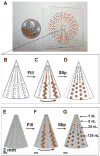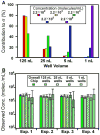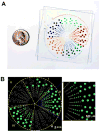Multiplexed quantification of nucleic acids with large dynamic range using multivolume digital RT-PCR on a rotational SlipChip tested with HIV and hepatitis C viral load
- PMID: 21995644
- PMCID: PMC3216675
- DOI: 10.1021/ja2060116
Multiplexed quantification of nucleic acids with large dynamic range using multivolume digital RT-PCR on a rotational SlipChip tested with HIV and hepatitis C viral load
Abstract
In this paper, we are working toward a problem of great importance to global health: determination of viral HIV and hepatitis C (HCV) loads under point-of-care and resource limited settings. While antiretroviral treatments are becoming widely available, viral load must be evaluated at regular intervals to prevent the spread of drug resistance and requires a quantitative measurement of RNA concentration over a wide dynamic range (from 50 up to 10(6) molecules/mL for HIV and up to 10(8) molecules/mL for HCV). "Digital" single molecule measurements are attractive for quantification, but the dynamic range of such systems is typically limited or requires excessive numbers of compartments. Here we designed and tested two microfluidic rotational SlipChips to perform multivolume digital RT-PCR (MV digital RT-PCR) experiments with large and tunable dynamic range. These designs were characterized using synthetic control RNA and validated with HIV viral RNA and HCV control viral RNA. The first design contained 160 wells of each of four volumes (125 nL, 25 nL, 5 nL, and 1 nL) to achieve a dynamic range of 5.2 × 10(2) to 4.0 × 10(6) molecules/mL at 3-fold resolution. The second design tested the flexibility of this approach, and further expanded it to allow for multiplexing while maintaining a large dynamic range by adding additional wells with volumes of 0.2 nL and 625 nL and dividing the SlipChip into five regions to analyze five samples each at a dynamic range of 1.8 × 10(3) to 1.2 × 10(7) molecules/mL at 3-fold resolution. No evidence of cross-contamination was observed. The multiplexed SlipChip can be used to analyze a single sample at a dynamic range of 1.7 × 10(2) to 2.0 × 10(7) molecules/mL at 3-fold resolution with limit of detection of 40 molecules/mL. HIV viral RNA purified from clinical samples were tested on the SlipChip, and viral load results were self-consistent and in good agreement with results determined using the Roche COBAS AmpliPrep/COBAS TaqMan HIV-1 Test. With further validation, this SlipChip should become useful to precisely quantify viral HIV and HCV RNA for high-performance diagnostics in resource-limited settings. These microfluidic designs should also be valuable for other diagnostic and research applications, including detecting rare cells and rare mutations, prenatal diagnostics, monitoring residual disease, and quantifying copy number variation and gene expression patterns. The theory for the design and analysis of multivolume digital PCR experiments is presented in other work by Kreutz et al.
Figures






Similar articles
-
Theoretical design and analysis of multivolume digital assays with wide dynamic range validated experimentally with microfluidic digital PCR.Anal Chem. 2011 Nov 1;83(21):8158-68. doi: 10.1021/ac201658s. Epub 2011 Oct 7. Anal Chem. 2011. PMID: 21981344 Free PMC article.
-
Mechanistic evaluation of the pros and cons of digital RT-LAMP for HIV-1 viral load quantification on a microfluidic device and improved efficiency via a two-step digital protocol.Anal Chem. 2013 Feb 5;85(3):1540-6. doi: 10.1021/ac3037206. Epub 2013 Jan 16. Anal Chem. 2013. PMID: 23324061 Free PMC article.
-
Experimental investigation of confinement effect in single molecule amplification via real-time digital PCR on a multivolume droplet array SlipChip.Anal Chim Acta. 2024 May 22;1304:342541. doi: 10.1016/j.aca.2024.342541. Epub 2024 Mar 28. Anal Chim Acta. 2024. PMID: 38637051
-
Reading Out Single-Molecule Digital RNA and DNA Isothermal Amplification in Nanoliter Volumes with Unmodified Camera Phones.ACS Nano. 2016 Mar 22;10(3):3102-13. doi: 10.1021/acsnano.5b07338. Epub 2016 Feb 22. ACS Nano. 2016. PMID: 26900709 Free PMC article.
-
Digital isothermal quantification of nucleic acids via simultaneous chemical initiation of recombinase polymerase amplification reactions on SlipChip.Anal Chem. 2011 May 1;83(9):3533-40. doi: 10.1021/ac200247e. Epub 2011 Apr 8. Anal Chem. 2011. PMID: 21476587 Free PMC article.
Cited by
-
Compartmentalized Suspension Array for the Isothermal, Digital, and Multiplex Detection of microRNAs.J Am Chem Soc. 2025 Jul 23;147(29):25705-25714. doi: 10.1021/jacs.5c07214. Epub 2025 Jul 11. J Am Chem Soc. 2025. PMID: 40644347
-
Nanomaterial-assisted microfluidics for multiplex assays.Mikrochim Acta. 2022 Mar 11;189(4):139. doi: 10.1007/s00604-022-05226-4. Mikrochim Acta. 2022. PMID: 35275267 Review.
-
Statistical Analysis of Nonuniform Volume Distributions for Droplet-Based Digital PCR Assays.J Am Chem Soc. 2019 Jan 30;141(4):1515-1525. doi: 10.1021/jacs.8b09073. Epub 2019 Jan 15. J Am Chem Soc. 2019. PMID: 30605325 Free PMC article.
-
Nucleic acid sample preparation using spontaneous biphasic plug flow.Anal Chem. 2013 Sep 17;85(18):8641-6. doi: 10.1021/ac4012914. Epub 2013 Sep 4. Anal Chem. 2013. PMID: 23941230 Free PMC article.
-
Chemical analog-to-digital signal conversion based on robust threshold chemistry and its evaluation in the context of microfluidics-based quantitative assays.J Am Chem Soc. 2013 Oct 2;135(39):14775-83. doi: 10.1021/ja4062882. Epub 2013 Sep 24. J Am Chem Soc. 2013. PMID: 24060606 Free PMC article.
References
-
- Marcus JS, Anderson WF, Quake SR. Anal Chem. 2006;78:3084–3089. - PubMed
-
- Stahlberg A, Bengtsson M. Methods. 2010;50:282–288. - PubMed
-
- Grond-Ginsbach C, Hummel M, Wiest T, Horstmann S, Pfleger K, Hergenhahn M, Hollstein M, Mansmann U, Grau AJ, Wagner S. J Neurol. 2008;255:723–731. - PubMed
-
- Kern W, Schoch C, Haferlach T, Schnittger S. Crit Rev Oncol/Hematol. 2005;56:283–309. - PubMed
-
- Schmidt U, Fuessel S, Koch R, Baretton GB, Lohse A, Tomasetti S, Unversucht S, Froehner M, Wirth MP, Meye A. Prostate. 2006;66:1521–1534. - PubMed
Publication types
MeSH terms
Substances
Grants and funding
LinkOut - more resources
Full Text Sources
Other Literature Sources

